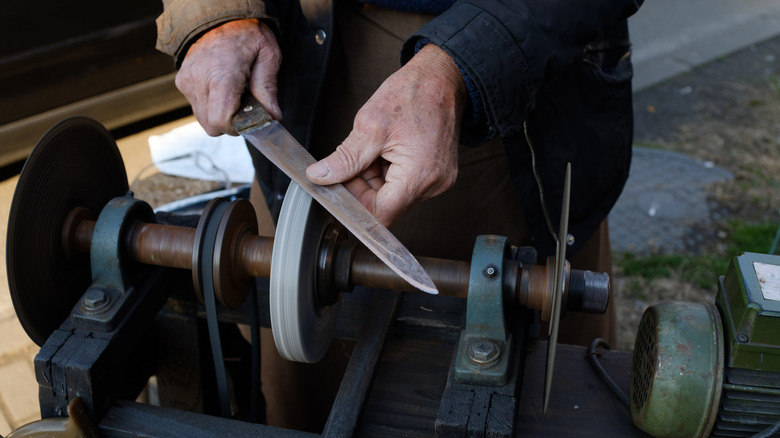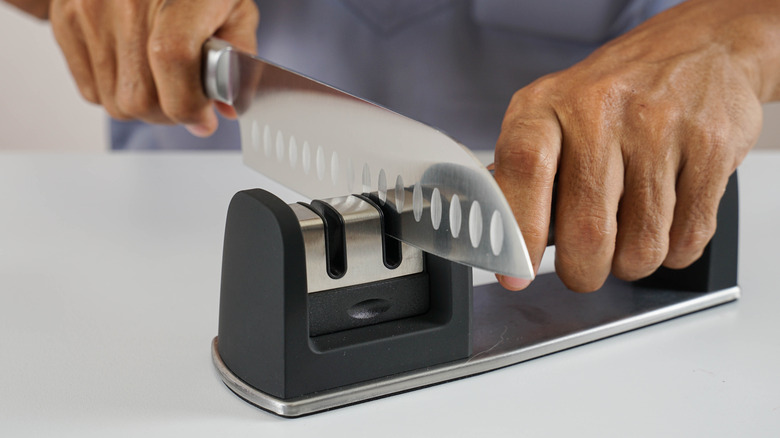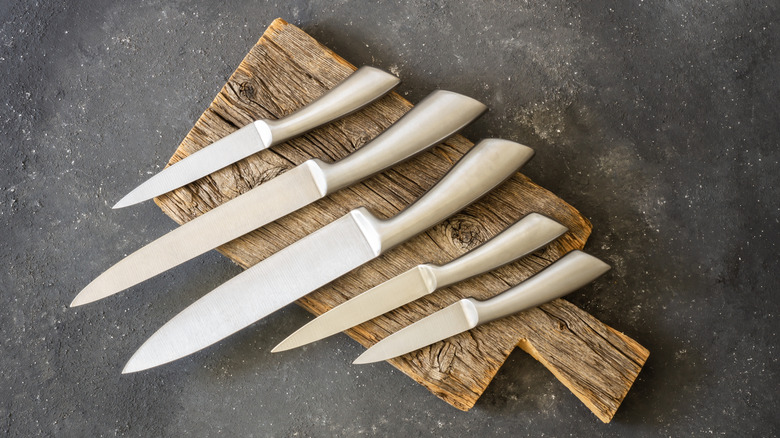Knife Sharpeners Vs Whetstones: What's The Difference?
We may receive a commission on purchases made from links.
Sharpening knives used to be a task you wouldn't want to do at home. It was often easy enough to take your knives to a sharpener, who could revive the blades with a large wheel-based grinder or other form of machinery. If you didn't want to find someone nearby who could do the work, there were knife-sharpening trucks that roamed the streets. While both still exist, mechanical and electric knife sharpeners and small sleek whetstones have made it easier for people to sharpen knives at home. Deciding which to use depends on how confident you are in your sharpening skills, your willingness to practice, and how often you plan to replace your knives.
Both whetstones and knife sharpeners work by creating a new sharp edge on a blade by removing some of the metal material that's left. This is different from honing, which realigns the existing edge. Choosing between a whetstone and a knife sharpener isn't easy since there are several types of each, and just as home cooks and chefs alike can be particular about how they maintain their knives and how often to sharpen them, they are also particular about which tool works best.
What is a knife sharpener?
With both manual (also called pull-through) and electric sharpeners, knives are dragged against an abrasive edge, either by pulling the knife through on your own or by having the machine itself guide the knife via motorized components. Since knives have different shapes, angles, and metals, often depending on where they are made, pull-through sharpeners often have two to four pre-sets for these different knives.
A sharpener made by the same company as your knife is likely set at the correct angles; otherwise, it's important to know whether you have a Japanese- or Western-style knife. Japanese knives are angled only on one side of the blade, while Western-style knives are double-edged. They are also angled to different degrees. Thankfully, some pull-through sharpeners, such as the Zwilling J.A. Henckels four-stage pull-through knife sharpener, have pre-sets designated for both Western and Japanese styles. The sharpeners also have fine and coarse slots, the former for simple polishing and the latter for blades that are especially dull.
Electric sharpeners are more likely to have three pre-sets: Fine, coarse, and honing. They also have different angles that allow you to use them with either Western or Japanese-style knives. One of the most popular styles is found in the Chef's Choice professional electric knife sharpener.
What is a whetstone?
A whetstone, also known as a sharpening or grinding stone, is a rectangular stone made of either synthetic or natural materials with abrasive particles that can create a new edge on your knives. You sharpen the blade simply by running the knife across the stone, which has been lubricated with either oil or water, depending on the type of whetstone used.
If you're thinking of the large wheel-like stone you'd find in a grinder's shop, think again. Whetstones, including the Sharp Pebble premium whetsone, are generally the length of your hand from the fingertips to the wrist, about two inches wide, and are often sold with a wood or bamboo non-slip base. Some, such as the Sharpal double-sided diamond sharpening stone, have a thin layer of diamonds which makes the stones more durable and better able to help sharpen dulled edges. The stones are often double-sided with one fine and one coarse, with abrasive particles that can have different densities and sizes measured by a number called grit. Grit ranges between 100 and 6000, starting from the most coarse to the most fine. Grits ranging from 200 to 1000 are best for damaged and dull blades, while those upward of 3000 are best for refining and polishing.
Is a whetstone or a knife sharpener better?
Those who have reviewed whetstones and sharpeners largely agree that whetstones are the best way to get the job done. What they don't agree on is whether the pull-through or electronic sharpeners are the next best thing. Pull-through sharpeners may be easy-to-use but pulling at the wrong angle can damage the knife by nicking or scratching the blade. Electric sharpeners are easier to use but unfortunately do their job largely by removing metal from the blade, which ultimately ruins the angle and weight of the knife. Whetstones cause less wear and tear and allow the user to have more control, but there's a bit of a learning curve.
Whetstones are also more flexible since they can be used with almost any knife. Given all of the different types of knives and the different ways to use them, it's important to have something that allows you to make sure they can all perform at their best.



